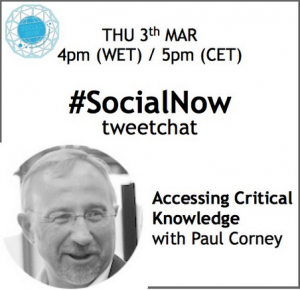
Keble College
I was back in Oxford last week staying at Keble College while attending the inaugural UK Improv for humanity event held at the Quaker Meeting House in St Giles.
Nancy White (of the KM4Dev community who’d collaborated with Mary Tyszkiewicz one of the Improv for humanity team) said it might be interesting. Trusting Nancy’s judgement, and always being on the lookout for ways to get out of my comfort zone while finding new ways to engage, I signed up.
The idea of using Improvisation in Humanitarian work is a couple of years old drawing on Applied Improvisation techniques described as:
Acting and responding in the moment without a script.
Applied improvisation uses the principles, tools, practices, skills and mind-sets developed in comedy, jazz and theatre and utilises them for non-theatrical or performance purposes.
With 62 delegates from over 20 countries it was well attended by Improvisation practitioners, many of whom were staying on for the annual meeting of the Applied Improvisation Network which followed, and humanitarian workers. Falling into neither camp I was there to learn and assess its applicability for pro bono and consulting work.
Here’s a snapshot of the event and some of the techniques I found interesting.
opening & closing techniques

Pablo Suarez leading a session
Most events of this type involve disruptive movement so people circulate and make early connections. As an interesting twist: we all stood in small circles and said our own names as we pointed to another who then did the same. After a minute the process was reversed and we had to point at a person and say their name. Was it useful? Yes, a different way of doing introductions.
“I am glad you are here” followed. This involved a lot of circulating, smiling and hand shaking as we all spoke those words to everyone we bumped into. This morphed into “Why I am here / What I bring to the event”; self explanatory phrases which required us to reflect and share with the person standing next to us.
Day Two saw us singing in a circle prompted by Gabe Mercado a typically engaging and enthusiastic Filipino from Manila: Gabe like everyone I’ve met in the Philippines has a great voice so “Bazimba” (the title of the chant) was delivered pitch perfect and we all joined in with both the song and accompanying body movement. Though great for an offsite event I don’t think it would suit a conference of finance professionals or lawyers.
The event closed with “I like, I wonder, I wish”. We all were gathered into a circle and asked to reflect on our takeaways. One person said, “I like working with such a diverse group” and took a step forward when doing so. Those that shared that view also moved forward. Following that we did one more “I am really glad you were here”.
facilitation techniques
Those who facilitate events are often challenged bringing the group to order and regaining the initiative. Some use a bell or tap the microphone (if there is one). When neither is available “one hand up all hands up” is particularly useful because it applies peer pressure and brings the room to order in a collaborative manner.
Keeping to time is an art. I did like Gobe’s idea of “The Time Hugger”, his description of one of his roles at the event. Every time someone overran the Time Hugger would intervene.
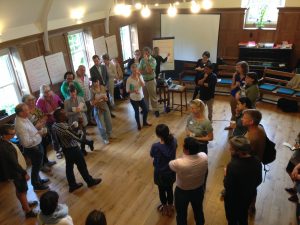
Debriefing
1>2>4>All describes a process wherein a question or topic is posed to the group. Each person reflects and then shares their thoughts with their neighbour. They then share with another pair and the 4 select the ‘best’ idea to share with all.
In a working group I attended we discussed how to enthuse and train a group of volunteers to then go and collect data and stories from the field. I was reminded of something I learned many years back (and don’t use enough) that for most impact in workshops the facilitator should break sessions into 20 minute segments. So some theory followed by practice and then reflections.
A couple of weeks back I commented on how Patrick Lambe and his colleagues at Straits Knowledge had used a case study show, tell and invite technique at their event in Singapore. Here’s the approach they used:
- Case outline to a common format in advance, in the conference programme
- Each case has a 6 min plenary pitch
- Three cycles of 25 min discussions on the cases at tables, in k-cafe style
A similar approach was used in Oxford based more on the Ignite Format. Each presenter had 4 minutes for 5 slides to showcase their case study. Each participant was then free to wander and join the group they were most interested in. I lean towards Patrick’s approach with defined cycles rather than “Go where you want when you want”.
engagement techniques

Yes And – the Pros
One of the techniques I previously used with my colleagues at Sparknow was Yes And. It was showcased in Oxford as a great way of shifting mindset. What I did like was the discussion around the danger of it becoming a self reinforcing scenario. If people don’t challenge constructively then its easy to go into a warm but negative spiral which in a humanitarian context can be fatal.

Heroic Improvisation Model being shown by Gabe
Mary’s case study focused on the Heroic Improvisation Model she’d developed following a humanitarian crisis in the Philippines. Heroic Improv recognises that most people are heroes and that communities follow these patterns of behaviour – it’s where community resilience occurs.
I see its potential business application in Disaster Recovery.

Pablo’s throwing a Frisbee in The White House
Everyone warmed to the Frisbees in the White House story provided by Pablo Suarez, from Red Cross/Red Crescent Climate Change Centre, who has championed the use of Improvisation games in Humanitarian situations.
Participatory games are emerging as one approach that can facilitate linking knowledge with action in the Climate Change arena.
Perhaps my favourite exercise was Story from a Word. Working in groups of 4-6 we were asked to create a story one word at a time. We were given a topic (Haunted House). If I said “dark” then my neighbour might answer “cobwebs” and her neighbour, “deserted”. And so on. The twist: each word could be ‘challenged’ by the rest of the group and the person who said it required to tell a true story about that word. A variation on It’s all in a Word it is a great way of getting a team to come together and learn more about each other.
listening & noticing techniques
Of the many techniques used during the two days 1-13 soft or loud provided a fascinating insight into how we align ourselves with people of a like disposition. Dr Barbara Tint asked us to pick a number between 1-13 and then having chosen it (and not told anyone else) to behave in the manner of that number. 1= quiet and submissive. 13= noisy and assertive. Obviously the 11-13’s tended to dominate the open space (we circled and spoke to each person we met) while the 1-4’s headed for the corners.
In a longer session outside I was allocated a score of 4 and asked to give a report to my boss who was a 12. His behaviour was very assertive and mine became defensive and submissive with a failure to challenge wrong statements. We flipped roles but kept our personas so my subordinate presented his report in a very dominant manner. Further examples served to illustrate the importance of having a balanced team making decisions and the ease with which we assume hierarchical stereotypes.
and finally
At the end of two fun days I was struck by 3 principles that underpin Improv interventions:
- Foundation & Safety – ensure you know what the downsides are if the intervention doesn’t work out as planned.
- Explanation -participants should know why they are doing or have done the intervention.
- Debrief – should be conducted after every intervention and ask these questions:
- What? (Happened)
- So What? (What impact did it have?)
- Now What? (What happens as a result?)
Having recently coached a virtual group on the use of various KM techniques and knowing what a challenge that proved I was left wondering if Improv techniques which rely so much on physical movement are capable of being transferred into a virtual environment.

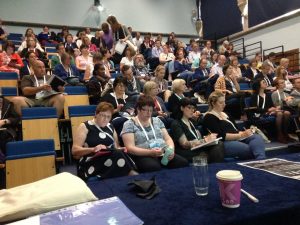 I wondered how many might turn up to mine and Andy Bent’s session in The Courtroom.
I wondered how many might turn up to mine and Andy Bent’s session in The Courtroom.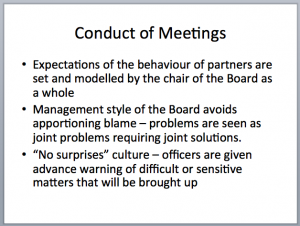
 Lauren Smith
Lauren Smith 
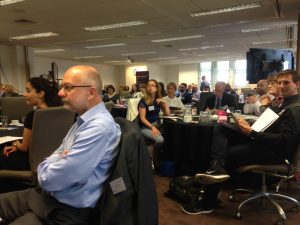 Well attended by 60 or so KIM professionals, it was chaired by Ian Rodwell
Well attended by 60 or so KIM professionals, it was chaired by Ian Rodwell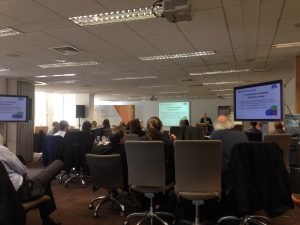 Learning that the Govt’s 5 year Knowledge & Information Strategy (GKIS) produced in 2013 is still not published and unlikely to see the light of day. Yet work is still going on as David Smith explained to create career pathways for the cadre of professionals who comprise the civil service’s Knowledge & Information Management profession. I didn’t get the feeling that CILIP are integral to those competency framework discussions which is a missed opportunity on both sides as there is no current industry group that effectively represent the KIM global profession as does a CMI or CIPD in Marketing or Human Resources (Personnel).
Learning that the Govt’s 5 year Knowledge & Information Strategy (GKIS) produced in 2013 is still not published and unlikely to see the light of day. Yet work is still going on as David Smith explained to create career pathways for the cadre of professionals who comprise the civil service’s Knowledge & Information Management profession. I didn’t get the feeling that CILIP are integral to those competency framework discussions which is a missed opportunity on both sides as there is no current industry group that effectively represent the KIM global profession as does a CMI or CIPD in Marketing or Human Resources (Personnel).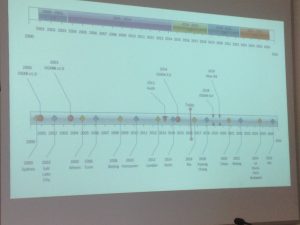 Christopher Payne’s
Christopher Payne’s 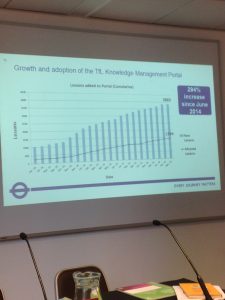 knowledge with the greater KM community so contact him or hear him speak.
knowledge with the greater KM community so contact him or hear him speak.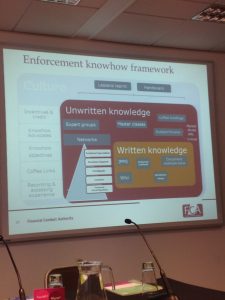 of people by using communities and having an easily understood framework. I noted though that poor search is a real barrier to adoption and that the lack of a technical underpinning a constraint.
of people by using communities and having an easily understood framework. I noted though that poor search is a real barrier to adoption and that the lack of a technical underpinning a constraint.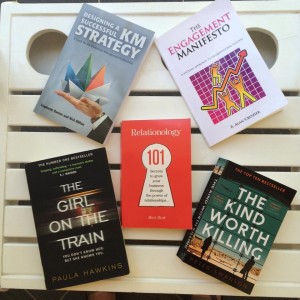 in constant anticipation and it kept my interest throughout. Great for a 5 hour plane ride.
in constant anticipation and it kept my interest throughout. Great for a 5 hour plane ride.
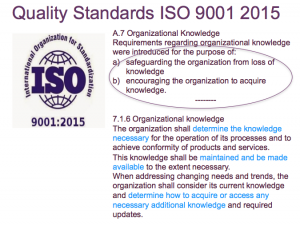
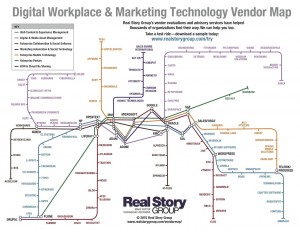 I was really taken by the closing Keynote from Tony Byrne of
I was really taken by the closing Keynote from Tony Byrne of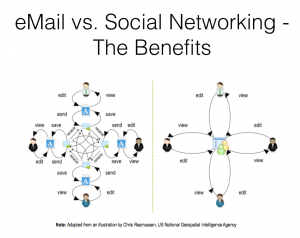 Luis ran the morning and I ran the afternoon. His method and justification for lowering email usage are compelling and I loved this slide that shows how a social networking platform can be a lot more efficient than using email.
Luis ran the morning and I ran the afternoon. His method and justification for lowering email usage are compelling and I loved this slide that shows how a social networking platform can be a lot more efficient than using email.
